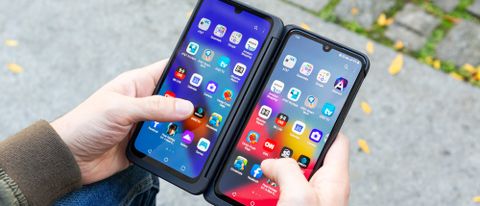Tom's Guide Verdict
The LG G8X ThinQ Dual Screen offers dual screens for maximum productivity and great battery life for a very reasonable price.
Pros
- +
Good price
- +
Excellent performance
- +
Dual-Screen case included
- +
Fantastic battery life
- +
Headphone jack
- +
Compatible with all carriers
Cons
- -
Dual-screen software has limitations
- -
Display is a bit dim
- -
Unremarkable cameras
Why you can trust Tom's Guide
The LG G8X ThinQ Dual Screen is a pleasant surprise from LG. The premise is simple: buyers get a removable cover case that adds a second 6.4-inch OLED display identical to the one inside the phone. You get all the versatility of a foldable phone, without the durability concerns or astronomically high price.
You don’t have to use the case, nor will you want to all the time — it adds a lot of bulk, and some kinks in the software keep it from being beneficial in every context. But that extra real estate certainly has its appeal, and even without it, the G8X is still one of the best phones available, at a very reasonable price.
- The best Android phones now
- Best phone battery life: The longest lasting phones
LG G8X price and availability
The LG G8X ThinQ Dual Screen starts at $649. The phone is available at AT&T and Sprint, as well as through B&H and Amazon. At launch, the phone will come with the Dual-Screen attachment no matter where or how you purchase it, though LG tells us it will offer the case separately as an add-on at a later date, for a price yet to be determined.
Anyone looking to avoid an installment plan through a carrier can choose to buy the G8X Dual Screen unlocked and take it to any network, as the phone supports all the bands used by wireless providers in the U.S. There’s only one configuration — a model with 6GB of RAM and 128GB of storage — though you’re free to expand the latter by up to 2TB using a microSD card.
LG G8X ThinQ Dual Screen specs
| Price | $699 |
| Display (Resolution) | 6.4-inch OLED (2340 x 1080) |
| Rear Camera(s) | Dual: 12-MP primary (ƒ/1.8); 13-MP ultrawide (ƒ/2.4) |
| Front Camera(s) | 32 MP (ƒ/1.9) |
| CPU | Qualcomm Snapdragon 855 |
| RAM | 6GB |
| Storage | 128GB |
| microSD | Yes; up to 2TB |
| Battery | 4,000 mAh |
| Colors | Aurora Black |
| Size | 6.27 x 2.98 x 0.33 inches |
| Weight | 6.77 ounces |
Design: A lot of phone
Untethered to the Dual screen case, the G8X ThinQ barely looks different from LG’s last several flagships, whether you’re comparing it to the original G8 or the newer V50 ThinQ 5G. The fact that LG has blurred the distinctions between its two premium lines doesn’t help the G8X stand out, either.
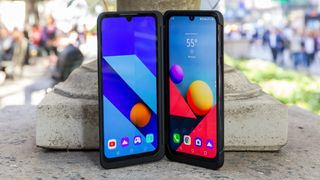
There’s no getting around it — the G8X is an intimidating device in its dual-screen guise.
There’s nothing particularly wrong with the G8X’s design; in fact, the phone’s biggest fashion crime might be that’s it’s simply too forgettable. The omission of the depth-sensing Z Camera on the earlier model has allowed LG to pare down the notch on the main display to a teardrop shape, which has definitely helped streamline the aesthetics.
I’m also intrigued by the lack of a camera bump on the back, which makes the G8X the only high-end handset in recent memory (save for its predecessors) to keep its lenses neatly tucked beneath the rear glass. LG also deserves props for retaining the headphone jack here, as it’s one of the only phone makers that still makes a habit of including one.
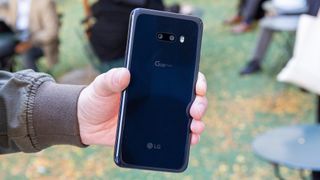
At 6.7 ounces, the G8X is more than a full ounce lighter than the iPhone 11 Pro Max. It’s only when you attach the 4.72-ounce Dual-Screen case that the G8X really makes its presence known.
There’s no getting around it — this is an intimidating device in its final, two-screen form, and one that’s almost impossible to use comfortably one-handedly. LG’s 360-degree Freestop Hinge allows you to flip the second display onto the back, which at least allows for semi-effective two-thumb typing — though it’s still a bit of a reach (particularly for your left hand, as that hinge is quite thick.)
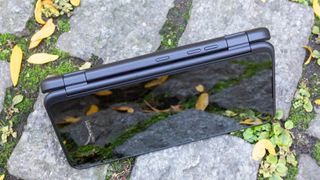
However, with that thickness comes strength. The Freestop Hinge can indeed pivot to any point and stay put, and it feels rock solid. But the case isn’t perfect. The volume and Google Assistant buttons, which are accessible through extra keys on the hinge, are essentially obscured when the second screen is folded out. It makes you wonder why LG didn’t simply line all those buttons down the right side of the device.
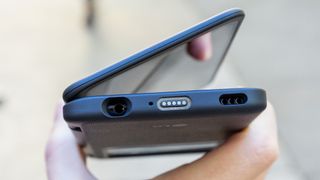
Because the phone’s USB-C port is occupied in Dual-Screen mode — that’s where you plug in the second screen — there’s a magnetic port on the exterior of the case that requires a proprietary MagSafe-style dongle (which is supplied in the box), so that USB-C cables or accessories can plug into the G8X. As a one-time MagSafe loyalist, I was looking forward to this, until the breakaway design quickly proved more frustrating than useful. The magnetic latching is too weak, and if the charging cable gets the slightest bit snagged, the dongle is in turn pulled upward or downward, severing the connection.
I do like the 2.1-inch LCD strip on the front of the Dual-Screen case, which relays simple information, like the date and time, connectivity status, battery level and notification icons. However, I’m less of a fan of the mirrored surface that blankets it, which easily picks up fingerprints. At least a hole for the speaker grille up top means you can still take calls on the G8X when closed; in such situations, the Google Assistant button on the side is used to accept or reject calls.
Dual Screen: Hit and miss
The G8X is the best two-screen phone I've ever used, but who am I kidding — that’s as faint as praise gets. It's not as if LG has had quality competition in this space, and previous multi-screen offerings from the likes of ZTE’s Axon M and others have been curtailed by messy software.

But the G8X works in dual-screen guise most of the time, and that's because LG hasn't tinkered with the traditional Android-user experience too much. It's a surprisingly straightforward affair; just open the case, and the second display essentially functions as another phone, with its own home screen. There are scenarios where certain apps (like web browsers or YouTube, for example) can span across both halves, but for the most part, the extra real estate is deployed for dual-wielding apps, which happens to be what the G8X does best.
Managing all that space is easy thanks to a handy three-finger-swipe gesture, which instantly moves any app open on one display onto the other. There's also an on-screen button that expands to list all dual-screen-related controls, like swapping the content between the displays and turning off the extra screen.
That's not to say that there aren't some quirks that make the experience rougher than we’d like. Chrome is the G8X’s default browser, as it is on most Android phones — yet this is one of those rare cases where you sort of wish it wasn't. There are no provisions in Chrome to move individual tabs between displays, so you’re forced to run a separate instance of the app (each with its own sandboxed tabs) for two-screen browsing. There is a third party alternative — Whale Browser by Naver — that is optimized for LG’s dual-screen system, though it doesn’t come preinstalled, which feels like a missed opportunity.

Gaming can be a bit of a head-scratcher, too. You can use the second display as a virtual gamepad, and to that end LG provides several templates: a console-style layout, one with a steering wheel for racing games, another that resembles a fight stick and a retro-inspired basic option. The console option registers as a physical gamepad in titles that support them; however, you can also build your own custom controller with an editor, and tie any virtual buttons you place to touch-screen inputs.
A handy three-finger swipe gesture makes it easy to move apps across displays.
It's all very well thought through — save for the process of actually launching games in the first place. When gaming in dua- screen mode, the natural thing to do is use the main display as the controller, because the half of the case with the phone in it is significantly heavier than the other, and playing in a flipped fashion would make the device far too top-heavy to hold.
However, the G8X doesn’t default to this orientation. In fact, depending on which display you open LG’s Game Launcher app in, and the order in which you summon the pad and the game itself, you can very easily find yourself in a situation where everything’s on the opposite screen from where it should be.
The funny thing is, on some level LG was aware that this could happen, so it cleverly provided a software button on the pad to switch displays. Unfortunately, though, this button never actually worked in my experience — it was always greyed out. I’ve found that the best process of starting games in dual-screen mode is to open the Game Launcher in the second screen, then the LG Game Pad from there, and finally the title itself — but your mileage may vary.
And still, even when you get the gamepad situated just right, it doesn't always improve the experience. Racing fan that I am, I found the console-style pad was totally ineffective for Asphalt 9: Legends; the fake analog sticks were impossible to locate without looking at them, and far too cumbersome for cornering. Using the driving controller in tandem with haptic feedback definitely helped, though it still took quite a lot of getting used to.
Replacing digital inputs with yet more digital inputs doesn’t make the G8X Dual Screen a viable stand in for an actual controller, and so I’m not sure that there’s much value in this add-on for gaming. Rather, I think the extra space is best served for multitasking — like having a YouTube video running while you’re web browsing, or perusing a restaurant's menu on one screen while looking up directions on Google Maps in the other. And while LG’s stock keyboard resulted in a record number of awkward autocorrects, I have to commend the company for one stellar feature — a button which immediately screenshots whatever is on the other display, then appends it to a message. Brilliant.
G8X vs. Galaxy Fold: How are they different?
Reading this, you might be wondering how LG’s $699 dual-screen device compares to Samsung’s $1,980 Galaxy Fold. On the surface, the differences are vast — the Galaxy Fold has a single 7.3-inch, flexible AMOLED panel that literally folds in half, while the G8X has two separate displays joined by a central hinge.
Having a pair of screens instead of one big one obviously means that LG’s handset is less well-suited for expanded, tablet-style apps, though the G8X can drive two apps simultaneously with no problems. On the flip side, LG’s traditional approach of a two-screen clamshell is significantly more durable compared to the Fold’s flexible display, which is prone to punctures and failures, as we witnessed during the Fold’s rocky launch.
However, in other respects, the two devices are more similar than you might think. Both are powered by Qualcomm’s Snapdragon 855 system-on-chip, meaning that you can expect roughly equal performance no matter which you choose. And because both run Android, the user experiences are quite similar — save for LG’s and Samsung respective UI customizations, which have been added to make Google’s operating system more natural to use with unique form factors.
In short, Galaxy Fold buyers at this stage are really paying for the privilege of being among the first in the world to have a flexible display in the palm of their hands. The technology is exciting to watch, though seemingly not ready for widespread public consumption yet — making the G8X the much safer choice for anyone interested in a phone that folds.
Display: Absolutely fine, just dim
The 6.4-inch OLED panel on the G8X is pleasant enough most of the time — just not on the sunniest days.
That’s a casualty of its dim peak brightness of 403 nits. The iPhone 11 Pro Max (763 nits) and Samsung Galaxy S10 (611 nits) handily beat the G8X. Even the 429-nit Google Pixel 4, which is on the low-end in terms of modern OLED displays, squeaks out ahead of LG’s latest handset.

In other respects, there’s less to complain about. At a resolution of 2340x1080, the G8X’s display renders images and text that aren’t quite as sharp as those on the Quad HD+ panel inside the original G8, though I didn’t miss the extra pixels.
Color reproduction is still strong here, as the G8X registered 176.8% of the sRGB color space in our lab. That’s quite a lot higher than the iPhone 11 Pro Max (118.6%), Pixel 4 (130.1%) and OnePlus 7T (155.1%), indicating that LG’s panel is tuned for more saturated hues than the bulk of the competition out of the box. However, there are six other color profiles to choose from besides the default Auto setting available to G8X users, so those who don’t like what they see have free rein to tinker.
LG tells us that the OLED display in the Dual-Screen case is identical to the one used in the G8X itself, which explains why it has a purely cosmetic notch. Using the same panel off the production line not only saves costs, but ensures that the two displays are as closely calibrated as possible.
Still, we noticed a slight difference in white balance when comparing both screens. The phone’s panel seemed a tick cooler, though I wouldn’t say the discrepancy was egregious by any stretch; you’d only notice it when looking at the same website simultaneously on each display. Minute differences in OLED calibration are difficult to stamp out on the production line, so it’s something we can live with.
Cameras: Average dual lenses
It’s hard to believe technology has reached a point where a flagship phone with only two lenses on the back seems behind the times, yet here we are. The G8X partners a 12-megapixel (MP), ƒ/1.8 primary shooter, a 13-MP ultrawide on the back and a 32-MP camera for the front. That’s it.
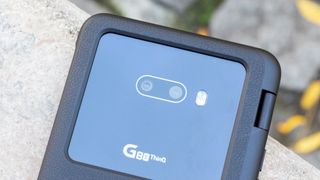
In other words, you won’t find a telephoto here to offer an optical zoom, or dramatic close-ups when shooting in Portrait Mode. While I might lament the lack of a true zoom lens, I have to concede that LG’s made the right call here by prioritizing the ultrawide, especially given the public’s fascination with the iPhone 11’s ultrawide camera.
That’s not to say LG hasn’t forgotten what really makes a great phone camera in 2019 — reality-bending software. Consider this shot I captured at Manhattan’s Herald Square using the G8X’s Night View mode. The Pixel 4’s rendition is admittedly better at dealing with the highlights, but the overall result also appears more obviously processed. In contrast, the example from LG’s phone sports a more natural-looking and evenly-distributed grain to it. The G8X doesn’t try too hard to resolve detail in the darkest regions, which actually works to its advantage in visualizing the environment the way our eyes do.
MORE: Best Smartphone Cameras 2019
It was a nice night, so I snagged one more picture from the same vantage point with the G8X — but this time, I used the ultrawide lens. This shot really illustrates how the shorter focal length can transform your shooting, though it comes with a tradeoff.

The 136-degree field of view of the G8X’s ultrawide lens captures more in the frame than, say, the 120-degree optics inside the iPhone 11. But the consequence is more distortion at the fringes. Phone makers have tried various methods to correct for the stretched, blurry fisheye effect you often get from ultrawide cameras — sometimes by using artificial intelligence, and other times by physically cropping into the center of the frame and discarding the fringes. Whatever tactics LG has employed, they haven’t helped much.
I came away less impressed by the G8X’s main camera outside the New York Public Library on a dreary October morning. Compared to the Pixel 4’s rendition, LG’s shooter produced an image devoid of contrast and detail, with overexposed shadows and no definition in the highlights.
Things didn’t get better for the G8X when I took it indoors to snag a portrait of my colleague Paul in Tom’s Guide’s studio. The iPhone 11 roundly defeats the G8X’s best effort here in every respect — the details in Paul’s face are crisper through Apple’s optics, the fabric of his knit sweater are sharper, and his hair isn’t unnaturally blurred. You could argue that the iPhone 11 applies too much of a reddish cast to his skin tone, but then, the gloomy, murky white balance of the G8X’s shot is hardly more desirable.
Finally, I flipped the G8X’s 32-MP front-facing cam around on myself to size it up with the Pixel 4’s 8-MP sensor. The G8X’s shooter incorporates a Quad Bayer filter to bin pixels together for more light sensitivity, though you could also opt for full-resolution 32-MP shots by tweaking the camera settings.
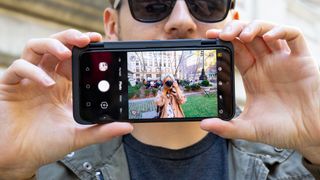
The G8X’s front-facing camera is especially important, because it’s the only lens that’s really available when the phone is in the Dual-Screen case. The second display obscures both rear cameras, so when the cover is on, you’re essentially forced to shoot using that extra panel as the viewfinder, while the main display faces the subject. It’s a trippy effect, to say the least — though I suppose it could be useful when enlisting the help of a stranger to take a photo of you.
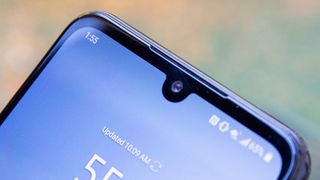
Ultimately, though, this camera isn’t as versatile as you'd hope. While I’m not in love with the deep shadows the Pixel 4 painted over my eyes in the selfie I took using Google’s handset, at least it avoids the cloudiness and flatness of the G8X’s contrast-free interpretation.
Battery Life: LG’s turned a corner
The G8X’s battery life is well within striking distance of the iPhone 11 Pro Max.
LG’s handsets have a habit of not performing particularly well in our battery test, but the G8X is different.
Just like the V50 ThinQ 5G, the G8X is armed with a 4,000-mAh battery. But unlike the V50, it can eke more endurance out of a single charge. The G8X lasted an impressive 11 hours and 49 minutes in Tom’s Guide’s battery test, which forces phones to endlessly load web pages over T-Mobile’s LTE network until their batteries run dry, at 150 nits of display brightness.
The G8X’s nearly 12-hour result is a far better showing than the last two LG phones we tested; the original G8 and V50 clocked in at 9:29 and 8:28, respectively. In fact, the time even shatters the OnePlus 7T’s middling 8:47 result — and that device’s battery is just 200 mAh shy of the one inside the G8X. And 11:49 is even well within striking distance of the iPhone 11 Pro Max’s 11:54 result.
The G8X needs all the juice it can get, because the Dual-Screen case doesn’t have its own battery. To measure how taxing that second display really is — and for our own amusement — we ran the G8X through our test again with both screens active. The juice only lasted 4 hours and 56 minutes, which is comically close to what you’d expect from lighting up twice the number of pixels.
Performance: Power to spare
The G8X might not technically be the most powerful Android flagship we’ve seen this year, but it’s sprightly enough to run two apps side-by-side on different screens without breaking a sweat. And that’s good enough.
With a Snapdragon-855 chipset at the helm and 6GB of RAM, the G8X is even with the Pixel 4 on paper, though benchmarks place LG’s phone ahead by a nose. Where Google’s flagship topped out with a Geekbench 5 score of 2,329, the G8X delivered 2,704 points, indicating slightly snappier overall performance. What’s more surprising is that the result isn’t far off the OnePlus 7T’s 2,759 peak — and that device benefits from Qualcomm’s newer 855 Plus processor, as well as 8GB of RAM.
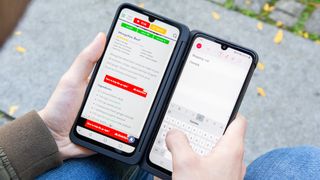
The G8X also bested Google’s latest hardware in 3DMark’s Sling Shot Extreme OpenGL ES 3.1 graphics test by a score of 5,308 to 4,923.
Those numbers translate well to everyday use, as the G8X certainly has the power to keep two displays humming along with different apps. The Dual-Screen functionality can be programmed to open an app automatically when the second display is turned on. I have mine set to auto-launch Chrome, and it’s never kept me waiting; my last tab is instantly within reach the moment I unfold the device.
Bottom Line
LG’s latest revision of its flagship G8 isn’t perfect, but it is pretty solid all-around, and offers a unique user experience if you choose to snap on the Dual-Screen case.
The Dual-Screen functionality isn’t perfect, butis a compelling benefit every now and again. Although that seems like a backhanded compliment, it’s probably the best thing about LG’s approach to its folding phone — you’re free to use it when you want to, and you’re not encumbered by it when you don’t. And the fact the case comes with the handset makes it far more compelling than if it were sold separately.
It also helps that the G8X ThinQ Dual-Screen is a respectable smartphone in many other ways, with dependable performance, long battery life, a good-if-not-great screen and — last but never least — a headphone jack. The relatively poor camera performance hampers the G8X a bit, but that’s a price some might be willing to pay for the phone's versatility. For better or worse, there’s really no phone like it out there today.
Adam Ismail is a staff writer at Jalopnik and previously worked on Tom's Guide covering smartphones, car tech and gaming. His love for all things mobile began with the original Motorola Droid; since then he’s owned a variety of Android and iOS-powered handsets, refusing to stay loyal to one platform. His work has also appeared on Digital Trends and GTPlanet. When he’s not fiddling with the latest devices, he’s at an indie pop show, recording a podcast or playing Sega Dreamcast.
